
Here is the text:
Intel employees,
As 2017 comes to a close, I want to reflect on this year and the progress we’ve made on our journey to transform Intel. Day to day, it can be hard to see how radically we are changing, yet when you add it all up, clearly it’s been quite a year!
I think back to the early 80s, when I was hired fresh out of college to be a process engineer in our New Mexico fab. Back then, we made memory chips called DRAMs. You probably know the famous story about how in 1985 Andy Grove and Gordon Moore, faced with a rapid decline in our core business, made a bet-the-company decision to get out of memory and switch to manufacturing microprocessors.
I was about three months into the job when my boss walked in and said, “We’re not in the DRAM business anymore. We’ll shut the factory down.” I remember calling up my father and telling him, “Well, I’ll be coming home.”
Instead, I watched as Intel made a massive shift. It required downsizing, new investments, and a lot of change. Yet in December 1997—20 years ago this month—Time magazine named then-Intel CEO Andy Grove its Man of the Year. Under his leadership, Intel had transformed from embattled memory maker to the world’s leading microprocessor company and a leader of the digital revolution.
Two decades later, Intel is again reinventing itself and I’m inspired by the accomplishments of this past year.
First I want to call out the phenomenal innovation this year from our client business. They showed the market what’s possible, and CCG’s success quarter after quarter is fueling the big bets we’re making in our future.
It’s almost impossible to perfectly predict the future, but if there’s one thing about the future I am 100% sure of, it is the role of data. Data is becoming the most valuable asset for any company. That’s why our growth strategy is centered on data: memory, FPGAs, IOT, artificial intelligence, autonomous driving. Anything that produces data, anything that requires a lot of computing, the vision is, we’re there.
I believe almost everything that impacts our lives—whether it’s healthcare or driving, retail or government—it will all be touched by our technology over the next 5 to 10 years. The world will run on Intel silicon.
We’re just inches away from being a 50/50 company, meaning that half our revenue comes from the PC and half from new growth markets. In many of these new markets we are definitely the underdog. That’s an exciting challenge – it requires that we develop and use new, different muscles.
The new normal for Intel is that we are going to take more risks. The new normal is that we will continue to make bold moves and try new things. We’ll make mistakes. Bold doesn’t always mean right or perfect. The new normal is that we’ll get good at trying new things, determining what works and moving forward.
The new normal is that as we go after new business, people will come after us. The new normal is that we embrace change and act as One Intel—a hungry, aggressive company not content to play defense but instead fired up to go after a $260 billion TAM.
As we look ahead to Intel’s 50th anniversary next July, I think about Bob Noyce’s inspiring challenge to all of us: “Don’t be encumbered by history, go off and do something wonderful.”
We have the opportunity to look to the future and embrace a new Intel, a different, fast-paced, global enterprise that’s adapting and growing.
As we prepare to celebrate the holidays with families and friends, I want to thank each of you for your tireless contributions to our many achievements this year—from ingenious new products and futuristic technologies to exciting acquisitions such as Mobileye to our leadership in social responsibility.
As we end what our forecast predicts is a record year and look ahead to celebrating a half-century of innovation that has profoundly changed the world, I could not be more proud to lead this company. Thank you for joining me and your Intel colleagues around the world on this remarkable journey.
Happy holidays!
BK
In November Krzanich reported he had sold 245,743 Intel shares leaving him with the bare minimum of 250,000 shares required for the CEO to hold under Intel’s corporate regulations.
 Electronics Weekly Electronics Design & Components Tech News
Electronics Weekly Electronics Design & Components Tech News



